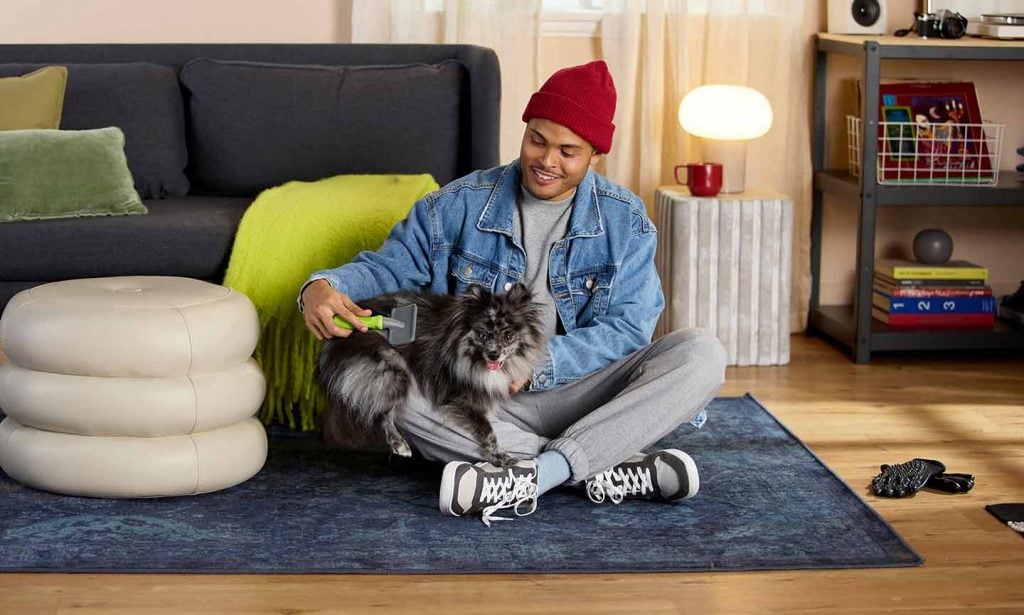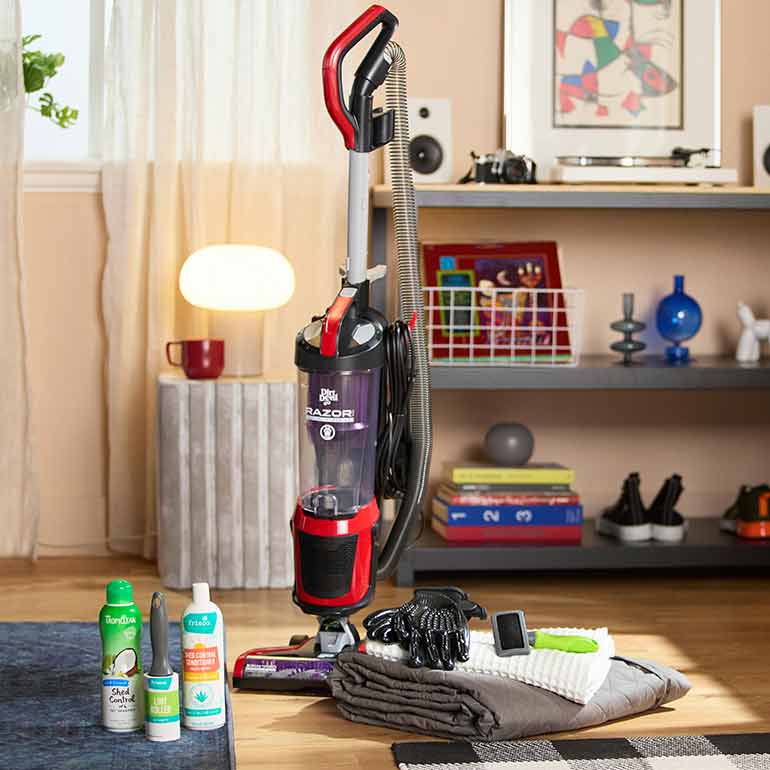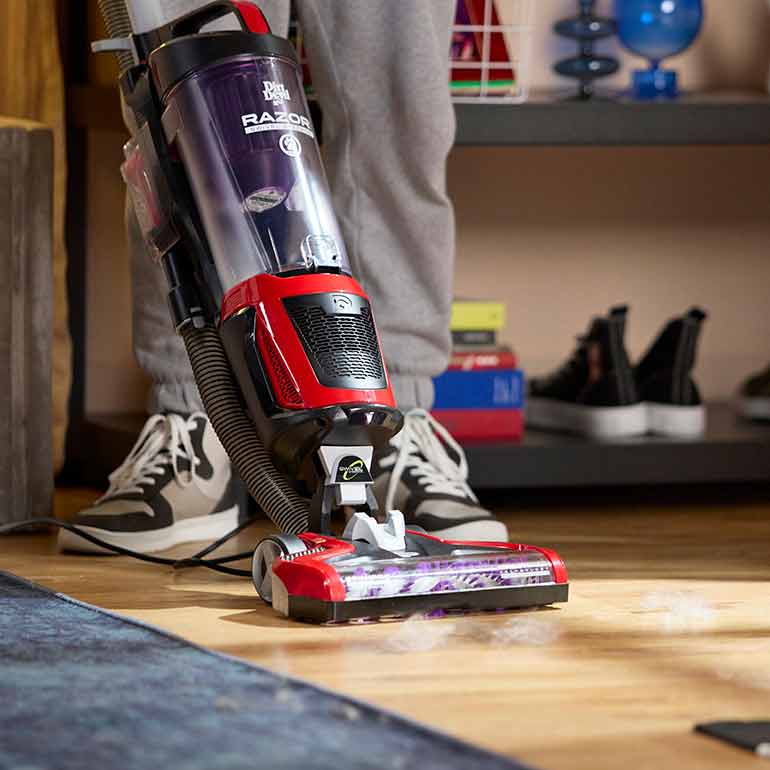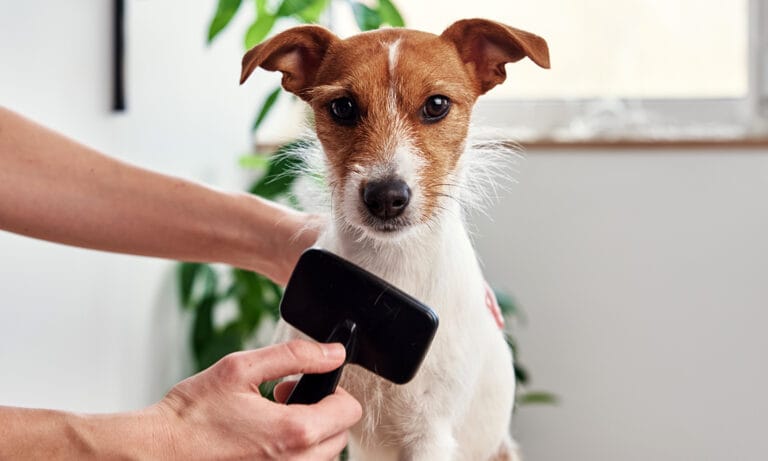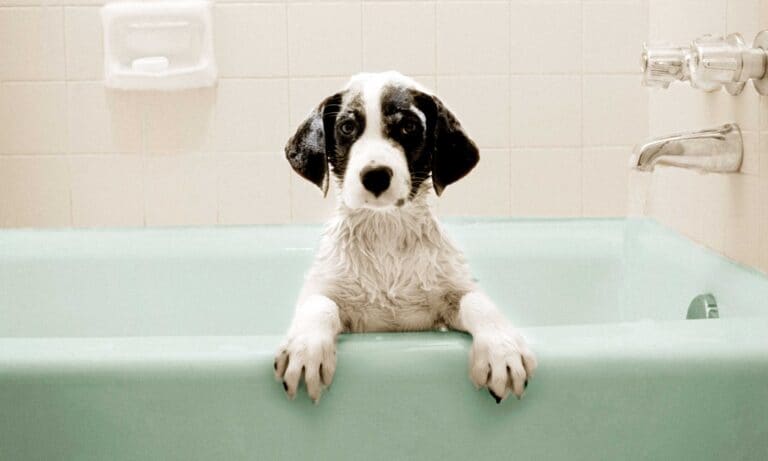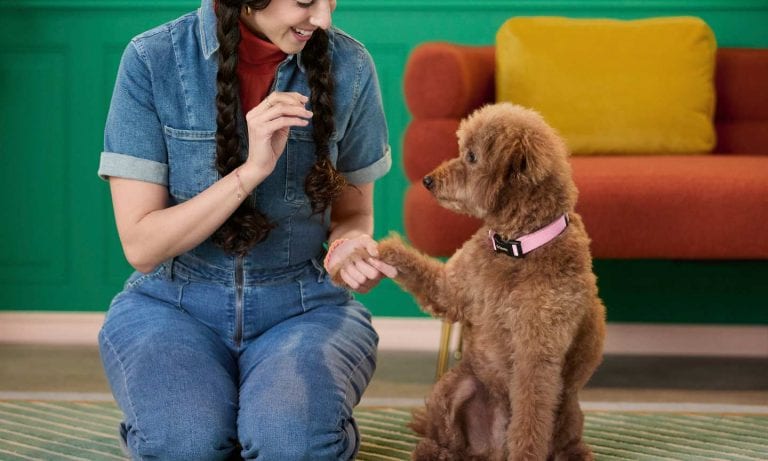You love your sweet pooch more than life itself. But the fur they leave around your house? Not so much. If you’ve ever found yourself wondering, “How is it possible for this creature to release this much hair?!” know that you’re definitely not alone in this battle.
Depending on your dog’s breed, you might experience year-round shedding and/or heightened periods of shedding when the seasons shift. But here’s the good news: With high-quality deshedding tools and regular brushing and grooming, you can nip those furball tumbleweeds in the bud.
In This Guide
How to Deal with Dog Shedding: Step-by-Step
1Gather Your Supplies
Here’s what you’ll need to help tackle dog shedding.
- Dog shampoo and conditioner
- A dog brush or dog grooming gloves
- Dog wipes
- Furniture covers
- A vacuum (ideally one that’s designed to pick up pet hair)
- A manual pet hair remover, such as a lint roller
2Give Your Dog a Bath
Bath time doesn’t just make for cute pics. Regular baths helps dislodge excess loose hair, dead skin cells, dander, and dirt—so less of all that stuff will end up on your clothes and sofa. At the same time, it nourishes your dog’s skin and helps their coat look shiny and soft.
Choosing a shampoo with gentle ingredients, like the Burt's Bees Oatmeal Dog Shampoo, will keep your dog's skin and coat healthy which helps reduce shedding. If you need some extra help during shedding season, using a deshedding shampoo like the FURminator Deshedding Dog Shampoo may help.
Most dogs need a bath about once every month or two throughout the year to keep shedding at bay, and about once every two to four weeks in the height of the spring and fall shedding seasons. But different dog breeds have different bathing requirements—some will need more frequent baths, while others only need baths a couple times a year. Look up your dog’s breed here to find out what’s typically recommended for them, and if you have any questions about picking a shampoo or how to groom your pup, ask your veterinarian or groomer.
Need a primer on giving your dog a bath? We’ve got you covered.
3Brush Your Dog Regularly
Depending on your dog’s breed and the time of year, they may need to be brushed multiple times a day, once a day, several times a week, weekly or monthly. You’ll know they need brushing if the house is filling with loose fur, they release a lot of dead hair when you pet them, or if they’re more focused on grooming themselves.
Different coat types will require different dog brushes. Slicker brushes are great for long-haired dogs, while curry brushes can help ease the shedding short haired dogs experience. If you're not sure how to brush your dog or which tools are best, you can check the grooming recommendations for their breed here, or ask your vet or groomer what’s right for them.
Undercoat
Noun / UN-der-COTE
The part of a dog’s coat coat that grows closest to their skin coat. In some breeds the undercoat is thicker or has a different texture than their outer coat
Along with shampooing and brushing your dog as needed, consider using dog grooming wipes in between baths. Wet wipes might seem simple, but they can make a big difference in shedding and allergies, as well as minimizing odor, dust and dirt.
4Cover Surfaces
One of the easiest ways to prevent dog hair from taking over your house is to protect the surfaces where your pooch hangs out most. Drape a pet-approved sofa cover (like the FurHaven Water-Resistant Reversible Furniture Protector) over their favorite couch and place a cozy throw blanket, like the Best Friends by Sheri Shag Dog & Cat Blanket on “their side” of the bed.
5Vacuum Often
Set the broom aside and break out a vacuum equipped for tackling pet hair, like the Shark Rotator Pet Upright Vacuum.
“Vacuums have special furniture attachments that actually pick up the pet hair and keep it in one spot—in the vacuum,” notes Vera G. Peterson, president of Molly Maid, a franchise of professional home cleaning services. “When you sweep, you are just spreading around dog fur further into your house, since it will move around and fly through the air.” A vacuum will also help pick up dander, dust mites, dead skin cells and other gross stuff that accumulates.
6Dry-Wipe
Along with regularly vacuuming up loose hair, Peterson recommends dry-wiping surfaces your dog frequents. There are a handful of tools that can help with this, including the ChomChom pet hair remover, and basic lint rollers, like the Frisco Cat & Dog Hair Lint Roller.
Peterson says that using a glove—like the Wags & Wiggles Rubber Dog Grooming Glove—is one of her preferred methods for removing pet hair from fabric surfaces.
“Rub down the surface with the pet hair and it will come off and stick to the glove,” she says. “This is a quick solution that doesn’t require you to haul out a vacuum, plus the rubber gloves can be reused over and over again.”
Why Is My Dog Shedding So Much?
Some dog breeds shed more than others due to their type of coat, and many breeds go through periods of time where they shed more than usual (e.g. spring and fall seasonal shifts and when outgrowing puppy coats.) This is considered normal shedding and, while frustrating, you shouldn't be concerned.
That said, it’s possible for dogs to experience excessive shedding, which could indicate an underlying health issue that requires veterinary attention, says Dr. Carl Prior, DVM, owner of Park City Animal Clinic in Utah. If you notice any of the following signs, reach out to your vet:
- Bald spots
- Skin problems such as redness, flaking, swelling or irritation
- Pain or discomfort
- Excessive scratching or biting
- Fleas, ticks, mites or other bugs on your dog’s skin
- Higher than usual hair loss compared to your pet’s norm
- Lots of hair matting and tangles
- Reduction in self-grooming
Dog Breeds That Shed the Most
A dog’s breed is one of the biggest predictors of how much they’ll shed. And don’t let a short-haired dog fool you, pet parents! In some cases, breeds with shorter pet hair actually shed more than their long-haired brethren. Here are the top dog shedders out there:
- German Shepherds
- Chow Chow
- Golden Retrievers
- Siberian Husky
- Alaskan Malamute
- Corgis, including both Cardigan Welsh Corgis and Pembroke Welsh Corgis.
- Akita
- Collies, including Bearded Collies, Border Collies, and regular ol’ Collies
Discover more breeds known for high dog shedding.
Dog Breeds That Shed the Least
Curious about which breeds qualify as low shedding dogs? Some of the pups on this list might surprise you with the low amount of hair they shed.
- Terriers, including American Pit Bull Terriers, American Staffordshire Terriers, Airedale Terriers, Australian Terriers, Border Terriers, Boston Terriers and Bull Terriers.
- Boxers
- Poodles
- Schnauzers: Both Miniature Schnauzers and Standard Schnauzers shed a low amount of hair. (Giant Schnauzers are considered medium shedders.)
- Pomeranians
- Bulldogs
- Chihuahua
- Bullmastiff
Discover more low shedding dog breeds.
Win the War on Fur
Share:
